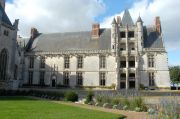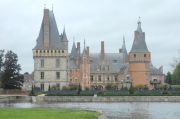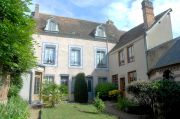A cycle route inaugurated in 2014 follows part of the Way of Saint James for more than 300 kilometres. Let’s discover the main tourist attractions to be seen between Paris and Tours.
[ Practical ]
Getting there
There are trains to Maintenon, Chartres, Châteaudun, Vendôme and Tours.
Lodging
Timotel Chatelet, in Chartres
Le Grand Monarque, in Chartres
Hôtel les Aubépines, in Illiers Combray
Hostellerie du Bois Guibert, in Bonneval
Le Saint-Louis, in Châteaudun
Entre Beauce et Perche, in Châteaudun
Hôtel Le Saint-Georges, in Vendôme
Moulin de la Plaine, in Troo
Les Roches Neuves, in Lavardin
Restaurants
Brasserie La Cour, in Chartres
Hôtel les Aubépines, in Illiers Combray
La Bonne Adresse, in Châteaudun
Aux Trois Pastoureaux, in Châteaudun
La Terre à TR, in Vendôme
Le Moulin Frabault, in Vendôme
Le Manoir de Saint Quentin, in Saint Quentin les Troo
Luggage transfer
Bagafrance
contact@bagafrance.com
Information
- Eure-et-Loir Tourist Office
www.tourisme28.com
- Loir-et-Cher Tourist Office
www.coeur-val-de-loire.com
- Indre-et-Loire Tourist Office
www.touraineloirevalley.com
- Cycle routes in Centre region
www.marandoavelo.fr
A popular destination for hikers and pilgrims, Saint Jacques de Compostela is not only reached by foot as the fame of the different hiking paths leading there could make you believe. Some people also get there by bike, using roads following as closely as possible these paths. Since late 2014, there is also a marked cycle route called Véloroute Saint-Jacques that follows part of the Via Turonensis, the longest Way of Saint James.

 Châteaudun castle © T. Joly Châteaudun castle © T. Joly
|
 Through the Beauce and Touraine regions Through the Beauce and Touraine regions
Passing through Tours, hence its name, it is used since centuries by Parisian pilgrims but also by those coming from Great Britain, Belgium, the Netherlands and Scandinavia. Cyclists can easily plan their journey thanks to the website www.marandoavelo.fr and a road book listing lodgings, restaurants, food stores, bike hire and repair shops and so on. There are also companies providing luggage transfer and bicycle transport along the way.
For the moment 350 km long, this relatively flat route goes from Rambouillet to Chatellerault, going through the Beauce and Touraine regions following the valleys of the Eure, Loir, Loire and Vienne rivers. An itinerary lined with major tourist sites.

 Maintenon castle © T. Joly Maintenon castle © T. Joly
|
 Maintenon Castle Maintenon Castle
To begin with Rambouillet whose state owned castle has in the past hosted international conferences and numerous foreign heads of state who came to hunt in the surrounding forest. Of medieval origin, it has been turned into a luxurious residence over the centuries. Surrounded by a French garden and an English garden, it was acquired by Louis XVI who built in the park a dairy for Marie Antoinette.
A few kilometres further appears Maintenon where stands a castle bought in 1674 by Françoise d'Aubigné, widow of the writer Scaron, and later secret wife of King Louis XIV and the governess of his illegitimate children. Therefore known as Madame de Maintenon, she embellished the building, restored it, built a magnificent wing leading to the chapel in order to allow the King to attend mass without going outside and asked famous landscapers Le Nôtre to design the garden.
 Stained glass art Stained glass art
Just nearby, the romantic ruins of an imposing aqueduct remind of the never completed mammoth project of the King to bring water from the river Eure to Versailles.
Then, after a ride in the Eure Valley, the towers of Chartres Cathedral loom on the horizon. World famous for its stained glass windows mostly from the twelfth and thirteenth centuries, this masterpiece of Gothic architecture decorated with thousands of statues has now got back its original interior appearance thanks to a major restoration.
Born in the Middle Ages, stained glass art suffers falls in orders from the Church but some workshops perpetuate the tradition by diversifying their production and by combining traditional and innovative techniques. Especially the Ateliers Loire that, since 1946, produces works to religious, public and private buildings all around the world. Open to the public, it gives the opportunity to discover all the steps in the production of stained glass and coloured glass blocks.

 Aunt Léonie's house © T. Joly Aunt Léonie's house © T. Joly
|
 In the footsteps of Marcel Proust In the footsteps of Marcel Proust
Continuing through the plain of the Beauce, the Véloroute reaches Illiers-Combray, a small town imbued with the memory of Marcel Proust who spent holidays there with his uncle and aunt when he was a child. Then, simply called Illiers, the town inspired the writer who renamed it Combray in "Swann's Way," the first part of his novel "In Search of Lost Time". So, in 1972, in order to honour him, the town council decided to attach the two names. Aunt Léonie's house, where he stayed, has become a museum combining rooms retaining their late 19th century furniture and the presentation of photos by Paul Nadar as well as of letters and manuscripts that belonged to relatives and Céleste Albaret, his housekeeper. The garden created by his uncle still exists as well. Of English style, this haven of peace is crossed by a small waterway and decorated with a fake cave, an Eastern-inspired dovecote and a small kiosk. Lastly, don’t miss the beautiful church dedicated to Saint-Jacques that boasts a boat hull inspired ceiling.
 The Venice of Beauce The Venice of Beauce
Further south arises Bonneval, nicknamed the Venice of Beauce because the former moats surrounding the old town are now filled with water and boat trips allow you to leisurely cruise around and discover the ramparts. Then the Véloroute passes through a lovely region made up of undulating agricultural landscapes and peaceful rivers. Built along the Loir, Chateaudun is worth a visit for its historical centre and its imposing castle perched on a rocky outcrop. A mixture of medieval, Gothic and Renaissance architectural elements, it has a remarkable exterior staircase, a rare hanging garden and houses a fine collection of French and Flemish tapestries.
About fifty kilometres away, Vendome has an equally rich heritage. Let’s name the powerful Saint-Georges gate, the Saint-Jacques chapel and the Trinity church both of Flamboyant Gothic style, the latter housing beautiful stalls decorated with representations of ancient crafts and a 12th century stained glass windows depicting the Virgin, one of the oldest of this kind in the world.
 Cave dwellings Cave dwellings
The cycle route then runs along the Loir valley lined with vineyards where is grown a rare grape variety, Pineau d'Aunis, which gives red wine a peppery taste. It is dotted with picturesque villages boasting many cave dwellings. With its cliff-side houses staggered on several levels, Troo is one of the two most beautiful and is well worth the short detour needed to get there. The second one is Lavardin that boasts no fewer than 450 cave dwellings as well as the ruins of a huge medieval fortress and a church decorated with superb frescoes.
If you are a plant enthusiast, pay a visit to the Plessis Sasnières garden. Ordered around a pond, it contains majestic trees, rare trees and shrubs, an apple tree covered pergola and many species of flowers. Then the Véloroute heads south and reaches the river Loire at Vouvray.
 The city of Saint Martin The city of Saint Martin
This wine village gives its name to an AOP famous for its sparkling and sweet white wines made from Chenin grapes. They age in huge caves dug into the cliffs along the river. A must see and tours going through all the steps of sparkling wine making end with a tasting of the different wines of this appellation. From there, it’s only a short ride along the Loire to get to Tours, which is accessed by a suspension bridge spanning the river. Resting place of Saint Martin and so a pilgrimage destination, the city has a lot to offer. Let’s name the impressive ruins of the medieval Saint Martin basilica, the graceful gothic Saint Gatien cathedral, the beautiful Goüin Renaissance mansion, ancient timber frame houses of the Plumereau square and a bustling nightlife.
April 09, 2016
Thierry Joly 

|



